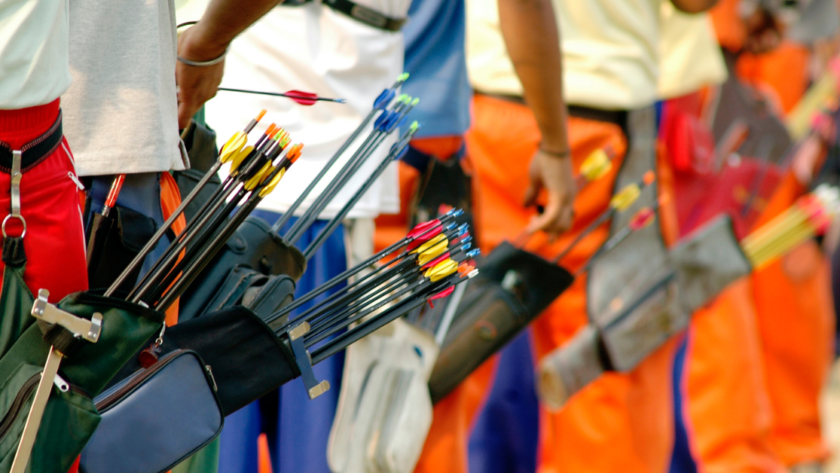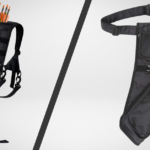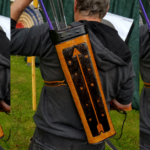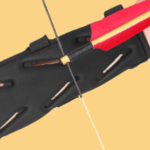As an avid archer, I’ve found that hip quivers are essential gear that can dramatically improve your shooting. They’re not just arrow holders – they’re tools that boost efficiency and performance for archers of all skill levels.
Whether you’re a seasoned bowhunter or target archery enthusiast, understanding hip quivers can elevate your archery game.
A Brief History of Hip Quivers
Hip quivers have a rich history dating back to ancient civilizations. The Egyptians and Assyrians recognized the practicality of keeping arrows at the hip for quick access.
Native American tribes took hip quivers to artistic heights, crafting intricate designs from animal hides adorned with symbolic beadwork.
In the Middle Ages, European archers favored hip quivers for their efficiency in warfare. This preference laid the groundwork for modern designs.
The 20th century brought a revolution in hip quiver technology, with new materials and manufacturing techniques expanding what’s possible.
The Anatomy of a Modern Hip Quiver
Today’s hip quivers are engineering marvels designed to meet diverse archery needs. Let’s break down the key components:
Arrow Storage
The primary function of any quiver is arrow storage, and hip quivers excel here. Modern designs can hold anywhere from 3 to 24 arrows, depending on your needs. Many feature adjustable dividers or foam inserts to keep arrows organized and prevent fletching damage.
Attachment System
A secure attachment is crucial for a hip quiver. Most models use a belt loop or clip system, allowing for easy on-and-off access.
Some high-end quivers feature quick-release mechanisms for situations where you need to shed gear quickly.
Material Composition
Hip quivers come in a range of materials, each with it’s own benefits:
- Leather: Offers a classic look and feel, often preferred by traditional archers
- Synthetic fabrics: Provide superior weather resistance and durability
- Composite materials: Blend lightweight properties with strength
Additional Features
Many hip quivers come equipped with extra pockets for small tools, broadheads, or other accessories. Some incorporate noise-reducing technology, making them ideal for bowhunting scenarios where stealth is paramount.
Benefits of Choosing a Hip Quiver
Opting for a hip quiver over other styles offers several advantages:
Improved Accessibility
With arrows at your hip, you can maintain your shooting stance while reaching for the next arrow. This leads to faster follow-up shots and improved overall efficiency.
Better Weight Distribution
Unlike back quivers, hip quivers keep the weight of your arrows closer to your center of gravity. This can improve your balance and reduce fatigue during long shooting sessions or hunts.
Enhanced Mobility
Hip quivers allow for greater freedom of movement, especially in tight spaces or when navigating through brush while hunting. You’ll find it easier to maneuver in various terrains and shooting positions.
Customizable Positioning
Many hip quivers offer adjustable can’t angles, allowing you to fine-tune the quiver’s position for optimal comfort and arrow retrieval. This customization can make a significant difference in your shooting experience.
Choosing the Right Hip Quiver for Your Needs
Selecting the perfect hip quiver involves considering several factors:
Archery Discipline
Your primary archery focus will greatly influence your choice of quiver:
- Target archers may prefer larger capacity quivers with precise arrow organization
- 3D competitors might opt for lightweight designs that don’t hinder movement
- Bowhunters often prioritize durability, stealth, and weather resistance
Capacity
Consider how many arrows you typically need to carry. A target archer might prefer a larger capacity quiver for extended practice sessions, while a minimalist bowhunter might opt for a sleeker, low-capacity design to reduce bulk in the field.
Material
Think about the conditions you’ll be shooting in. If you often find yourself in wet or rugged environments, a durable, weather-resistant synthetic quiver might be your best bet. For a more traditional look and feel, leather quivers offer timeless appeal.
Attachment System
Make sure the quiver’s attachment method is compatible with your preferred belt or archery gear setup. Some archers prefer a rigid connection, while others value the ability to quickly detach their quiver.
Additional Features
Decide which extra features are must-haves for you:
- Tool pockets for Allen wrenches or broadhead wrenches
- Arrow separators to protect fletching
- Noise-reducing technology for stealth in hunting situations
- Adjustable can’t for personalized positioning
Optimizing Your Hip Quiver Setup
Once you’ve chosen your hip quiver, it’s time to fine-tune it’s performance:
Adjust the Can’t Angle
Experiment with different angles to find the sweet spot that allows for easy arrow retrieval without interfering with your draw. This can take some trial and error, but finding the right position will greatly improve your shooting efficiency.
Organize Your Arrows
If your quiver has adjustable dividers, use them to group arrows by type or fletching color for quick identification. This organization can be particularly helpful in competitive situations or when hunting with different arrow setups.
Balance Your Gear
Distribute the weight of your archery accessories evenly around your waist to maintain proper balance. This might mean adjusting the position of your quiver or other gear to achieve the best overall feel.
Practice, Practice, Practice
Spend time getting used to drawing arrows from your hip quiver. The muscle memory you develop will pay off in faster, smoother shots.
Practice in various shooting positions to confirm you can access your arrows comfortably in any situation.
Common Pitfalls to Avoid
Even with the best hip quiver, there are some potential issues to watch out for:
Overcrowding
Resist the temptation to stuff your quiver beyond it’s intended capacity. Overcrowding can lead to damaged arrows and slower retrieval times.
It’s better to carry fewer arrows efficiently than to struggle with an overpacked quiver.
Neglecting Maintenance
Regularly inspect your quiver for wear and tear, especially around attachment points and arrow dividers. Clean your quiver after use, particularly if you’ve been in dusty or wet conditions.
Proper maintenance will extend the life of your gear and confirm it performs when you need it most.
Ignoring Regulations
If you compete in archery tournaments, make sure your hip quiver complies with all relevant rules and regulations. Some competitions have specific requirements for quiver type, capacity, or attachment methods.
Forgetting to Secure
Always double-check that your quiver is securely attached before heading out to shoot or hunt. A loose quiver can be a major distraction and potential safety hazard.
The Future of Hip Quivers
As archery technology continues to advance, we can expect to see some exciting developments in hip quiver design:
Smart Technology Integration
Future quivers may incorporate electronic components for arrow counting, shot tracking, or even integration with smartphone apps for performance analysis.
Advanced Materials
Researchers are constantly developing new materials that could offer even greater durability, weather resistance, and lightweight properties for quivers.
Biomechanical Optimization
As our understanding of body mechanics improves, we may see quiver designs that are even more ergonomically tailored to the archer’s form and movement.
Customization and 3D Printing
The rise of 3D printing technology could lead to highly personalized quiver designs, allowing archers to create bespoke solutions for their specific needs.
Caring for Your Hip Quiver
Proper maintenance will confirm your hip quiver serves you well for years to come:
Cleaning
Regularly clean your quiver with suitable products based on it’s material:
- For leather quivers, use a damp cloth and leather conditioner to keep the material supple
- Synthetic quivers can often be cleaned with mild soap and water
- Always allow your quiver to air dry completely before use
Storage
When not in use, store your quiver in a cool, dry place away from direct sunlight. This will prevent material degradation and maintain the quiver’s shape.
Repairs
Address any damage promptly. Small tears or loose stitching can often be repaired at home, but for more significant issues, consider professional repair services to maintain the quiver’s integrity.
Hip Quivers for Different Archery Styles
Let’s explore how hip quivers cater to various archery disciplines:
Target Archery
Target archers often prefer hip quivers with larger capacities and precise arrow organization. Features like adjustable dividers and tool pockets are particularly valuable for fine-tuning equipment between ends.
Field Archery
Field archers benefit from lightweight, weather-resistant quivers that can withstand diverse outdoor conditions. Quick-adjust features are helpful for navigating varied terrain and shooting positions.
3D Archery
3D competitors often choose compact hip quivers that don’t interfere with movement through simulated hunting courses. Noise reduction features can add to the realistic hunting experience.
Traditional Archery
Traditional archers may opt for leather hip quivers that complement their classic bows and arrows. These quivers often feature handcrafted details and natural materials.
Bowhunting
Hunters need durable, quiet quivers with camouflage or neutral colors. Features like broadhead storage and scent-blocking materials are particularly valuable in hunting scenarios.
Customizing Your Hip Quiver
Many archers enjoy personalizing their gear. Here are some ways to make your hip quiver uniquely yours:
Decorative Elements
Add personal flair with patches, embroidery, or painted designs. Just be sure any additions don’t interfere with the quiver’s functionality.
DIY Modifications
Some archers create custom pockets, arrow separators, or attachment systems to suit their specific needs. Always test modifications thoroughly before relying on them in competition or hunting situations.
Accessory Integration
Explore ways to mix other archery accessories with your quiver setup, such as rangefinder holders or release pouches. A well-organized system can improve your overall efficiency.
Hip Quivers vs. Other Quiver Types
While hip quivers offer many advantages, it’s worth comparing them to other quiver styles:
Back Quivers
Back quivers have a classic look but can be slower for arrow retrieval and may interfere with backpacks or treestands.
Bow-Mounted Quivers
These attach directly to the bow, keeping arrows close at hand but adding weight and potentially affecting bow balance.
Ground Quivers
Used primarily in target archery, ground quivers offer large capacity but limit mobility.
Pocket Quivers
These small quivers attach to a pocket or belt, offering minimal arrow capacity but most discretion for hunters.
Traveling with Hip Quivers
If you’re planning to travel for archery competitions or hunting trips, consider these tips for transporting your hip quiver:
Air Travel
Check airline regulations regarding archery equipment. Hip quivers often need to be packed in checked luggage.
Vehicle Transport
Secure your quiver to prevent damage during transit. Consider using a dedicated archery case that accommodates your quiver along with your bow and arrows.
International Considerations
Research customs regulations for archery equipment when traveling abroad. Some countries have strict rules about importing bows and arrows.
Environmental Considerations
As outdoor enthusiasts, archers should consider the environmental impact of their gear choices:
Sustainable Materials
Look for quivers made from recycled or sustainably sourced materials. Some manufacturers are now offering eco-friendly options.
Durability
Investing in a high-quality, durable quiver reduces waste by minimizing the need for frequent replacements.
End-of-Life Disposal
When your quiver has reached the end of it’s useful life, research proper disposal or recycling methods for it’s materials.
Hip Quivers in Archery Culture
Hip quivers have played a significant role in archery culture and media:
Historical Representations
From Robin Hood to Legolas, hip quivers have been prominently featured in literature and film, often symbolizing skill and readiness.
Modern Competitions
Watch any major archery competition, and you’ll see a variety of hip quiver styles used by top athletes. These choices often influence trends in recreational archery.
Social Media Influence
Archery influencers and content creators often showcase their hip quiver setups, driving interest in new designs and customization options.
Frequently Asked Questions
What is a hip quiver in archery?
A hip quiver is a type of arrow holder that attaches to an archer’s belt or waist, allowing for easy access to arrows during shooting.
How many arrows can a hip quiver hold?
Hip quivers typically hold between 3 and 24 arrows, depending on the specific design and intended use.
Are hip quivers allowed in archery competitions?
Most archery competitions allow hip quivers, but it’s important to check specific rules for each event or organization.
Can hip quivers be used for both recurve and compound bows?
Yes, hip quivers are versatile and can be used with both recurve and compound bows, as well as traditional bows.
How do I attach a hip quiver?
Most hip quivers attach to a belt using loops or clips. Some models may need a specific archery belt for secure attachment.
Are leather or synthetic hip quivers better?
The choice between leather and synthetic depends on personal preference and intended use. Leather offers a traditional look, while synthetics often provide better weather resistance.
How do I clean and maintain my hip quiver?
Cleaning methods vary based on the quiver’s material. Generally, mild soap and water work for synthetics, while leather may need special leather care products.
Can I make my own hip quiver?
Yes, some archers enjoy crafting DIY hip quivers. This can be a rewarding project but needs careful design to confirm functionality and durability.
Do hip quivers come in left-handed and right-handed versions?
While many hip quivers are ambidextrous, some designs are specifically tailored for left-handed or right-handed archers.
How much do quality hip quivers typically cost?
Hip quiver prices can range from around $20 for basic models to over $200 for high-end, feature-rich designs.
Key Takeaways
- Hip quivers offer improved accessibility and weight distribution compared to other quiver styles.
- Choose a hip quiver based on your archery discipline, required capacity, and shooting conditions.
- Proper adjustment and organization of your hip quiver can significantly enhance your shooting efficiency.
- Regular maintenance and awareness of potential pitfalls will confirm your hip quiver serves you well for years to come.
- The future of hip quivers looks bright, with innovations on the horizon that promise to further enhance the archery experience.



